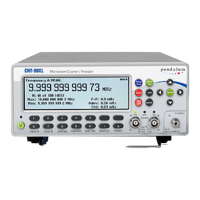The easiest way to measure the modulating
frequency is after demodulation, for instance
by means of a so-called RF-detector probe
(also known as a demodulator probe, e.g.
Pomona type 5815) used with AC-coupling of
the input channel. If no suitable demodulator
is available, use the
Freq Burst function to
measure the modulation frequency in the same
way as when measuring Burst PRF.
Measuring the modulating fre-
quency.
Press MEAS FUNC and select Freq
Press SETTINGS
Burst
Meas Time
and enter a measurement time that is
approximately 25 % of the modulating
period.
—
Press Sync Delay and enter a value that
is approximately 75 % of the
modulating period. See Fig. 4-3.
Press INPUT A and turn on Manual trig-
ger.
Press Trig and enter a trigger level that
makes the counter trigger according to
Fig. 4-9.
Even though the main frequency reading may
now be unstable, the PRF value on the display
will represent the modulating frequency.
Measurement
Reciprocal Counting
Simple frequency counters count the number
of input cycles during a preset gate time, for
instance one second. This leads to a 1 input
cycle count error that, at least for low-fre-
quency measurements, is a major
contribution to uncertainty.
However, the counters described here use a
high-resolution, reciprocal counting tech-
nique, synchronizing the measurement start
with the input signal. In this way an exact
number of integral input cycles will be
counted, thereby omitting the
1
input cycle
error.
Synchronization of a
measurement.
After the start of the set measurement time,
the counter synchronizes the beginning of the
actual gate time with the first trigger event
(t
1) of the input signal. See also Fig. 4-10.
In the same way, the counter synchronizes
the stop of the actual gate time with the input
signal, after the set measurement time has
elapsed. The multi-register counting
technique allows you to simultaneously
USER MANUAL ● CNT 9x Series ● Rev.22 February 2020

